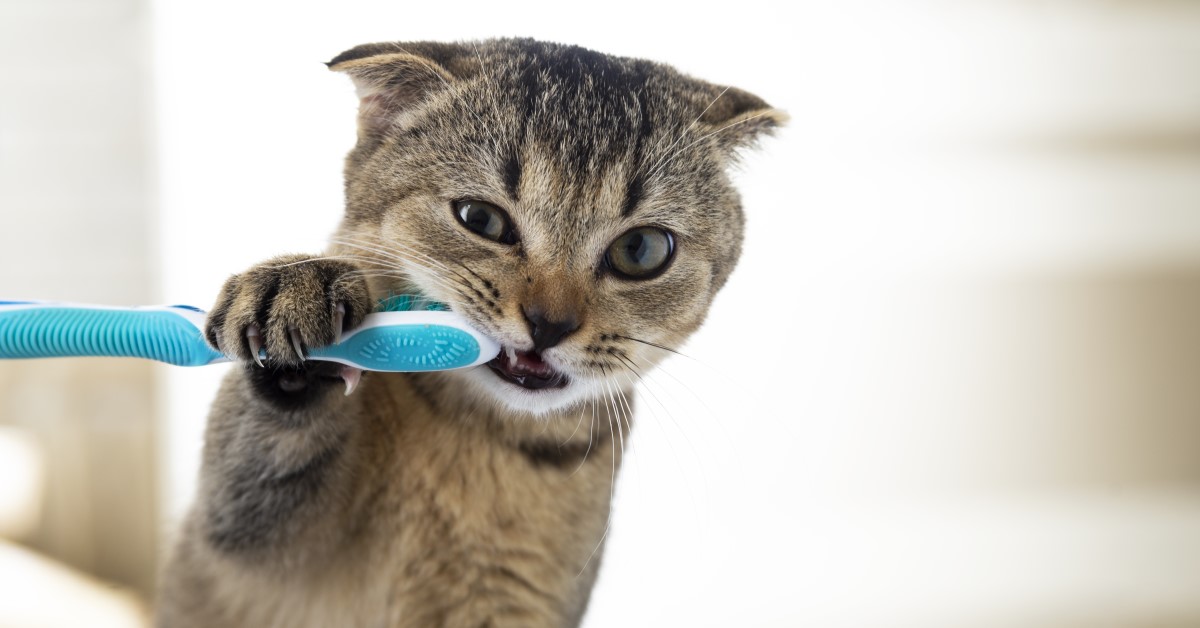Cat Dental Health: An Owner's Guide
Learn why cats need dental care and what forms of dental care pet owners should provide.

Cats can seem aloof, mysterious, or even indestructible at times. In reality, your favorite feline can fall prey to many of the same health issues that affect humans, including dental problems. When you consider that cats use their mouth for gripping and holding objects (or kittens) as well as eating, you can see how debilitating a painful dental condition can prove for your cat. Let's look at why cats need dental care, what happens when dental problems go unaddressed, and what types of dental care can enhance your cat's quality of life.
Normal Dental Development in Cats
What does healthy feline dentition look like? Like human babies, kittens are born without any erupted teeth. By the age of six weeks, they should display a total of 26 milk teeth or "baby teeth." These teeth fall out to make way for a set of 30 permanent teeth in adults. The gum tissue anchoring these teeth to the jaw should look pink and healthy. This arrangement not only helps your cat bite and chew food as the first step in healthy digestion, but it also allows cats to defend themselves against enemies, kill prey in the wild, and transport various items (including their kittens) from place to place.
Common Feline Dental Issues and Oral Disorders
Some cat dental problems stem from acute injuries, such as a cracked, broken, or knocked-out tooth. Others develop over time into increasingly serious conditions. Common examples of these disorders include:
- Gingivitis - This early stage of gum disease occurs when bacteria feast on dental plaque (a combination of saliva and bits of food). The cat's immune system reacts to this bacteria by producing inflammation, which causes gum tenderness, bleeding, and swelling.
- Periodontal disease - Untreated gingivitis in cats can lead to a more serious problem called periodontitis. At this stage, the tissues attaching the teeth to the jawbone may weaken and fail, allowing teeth to fall out. The bone density of the jaw may also decrease. In some cases, serious infections can develop which may then spread to other areas of the body, including the major organs.
- Tooth resorption - Older cats sometimes develop this mysterious, painful condition. The teeth deteriorate from the inside out, starting with the crowns and progressing to the roots.
- Oral cancer - Oral cancer in cats can take the form of lumps, lesions, or symptoms commonly associated with gum disease. Malignant oral cancers can threaten a cat's life.
Cats naturally try to hide any health problems they may be having so as not to display weakness. However, telltale signs that your cat may have a dental issue include food avoidance, drooling, bad breath, a swollen face, and a tendency to chew with the head turned sideways. When you look inside your cat's mouth, you may see clumps of plaque on the teeth, fractured teeth, unexplained tooth loss, a lump or lesion in the oral cavity, and red, swollen, or bleeding gums.
How Veterinarians Treat Feline Dental Conditions
Thankfully, veterinarians can treat most cat dental ailments effectively.
If your cat has gingivitis or periodontitis, your veterinarian may use scaling tools to scrape away the inflammatory debris while also prescribing antibiotics to kill germs. In some cases, extraction of severely infected teeth can protect surrounding teeth from suffering the same fate. Extractions can also relieve the pain of tooth resorption.
Oral cancer in cats may require a multi-pronged treatment approach. Your vet may recommend a combination of surgery, radiation, and chemotherapy to eradicate the cancer before it can spread.
The Value of Preventative Dental Care for Cats
Preventative cat dental care can help your cat avoid common tooth and gum problems. Make sure your cat receives annual wellness evaluations that include dental exams and professional teeth cleaning. These checkups allow your vet to notice and treat any disorders as early as possible. The sooner your cat receives the necessary dental care, the more easily the problem can be resolved, especially where oral cancer is concerned.
You can help your cat maintain healthy teeth and gums between veterinary appointments by learning how to brush your cat's teeth with a feline-safe toothpaste product. A finger brush, rubber appliance, or piece of gauze should yield good results. Your cat may come to see this ritual as a kind of treat if you use a cat toothpaste in a favorite flavor such as beef or chicken.
If you don't brush your cat's teeth every day, or if your cat simply refuses to allow it that frequently, try incorporating it into a bi-weekly grooming session. Your vet may also recommend products such as dental sprays which can help reduce plaque accumulation. During tooth brushing, remember to inspect your cat's mouth for signs of trouble.
A Healthy Mouth Makes for a Happier Kitty
As you can see, the state of your cat's mouth plays a key role in your cat's overall health and comfort. Take a proactive stance by scheduling those regular wellness exams and approving any necessary treatments. Then ask your vet any lingering questions you may have about preventative dental hygiene at home and common trouble signs that call for professional attention. Your kitty would do the same for you!
Ready to start saving money on pet wellness care?
Then take a look at Mint Wellness, the pet wellness plan that provides fast reimbursement on routine pet care. Save on vaccinations, wellness exams, preventatives, dental, and more!
Learn More


